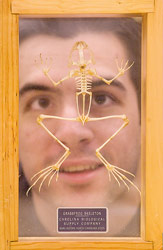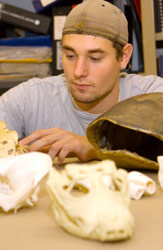Campus Update
By Vinny Reda (October 31, 2007)
Bones Bare Ancient Patterns of Life
 |
|
|
Sean Pipkin identifying bones of animals once used in the Maya diet. (Photo by Mark Schmidt) |
|
Sean Pipkin gazed down diligently at his lab table, and finely wielded a thin stick so as to keep his Dasypus novemcinctus apart from his Meleagris ocellata.
Separations had to be distinct with the several small piles of tiny bones that lay upon his lab desk in the Arts & Sciences Building. Pipkin was not only developing his skills in faunal identification and vertebrate anatomy, but he and his fellow handful of zooarcheology students were participating in actual anthropological research on Maya sites from Belize.
"The students are helping with an original research project that will reveal to various audiences — including the public, academia, and the Maya peoples themselves — ancient patterns of human ecology and economy," said Professor Marilyn Masson, who is instructing the course — Anthropology 431 — this fall.
Pipkin and others began their study by identifying from photos and collections the more than 50 genus and species the class possessed from a 1996-2002 archeological dig at Progresso Lagoon, Belize. For instance, Dasypus novemcinctus is the armadillo, Meleagris ocellata the oscellated turkey.
 |
||
|
UAlbany Senior Sean O'Brien said the course made such an impact on him, he is joining a Department of Anthropology field course in Belize this winter. (Photo by Mark Schmidt) |
||
"Having taken a class on Maya art and archaeology, and learning about the different rituals involving animals, it was particularly interesting. For example, I learned that a lot of Maya used deer bones in their burials. Working with the bones actually made these rituals much more real to me."
The inspection of fauna that the Maya hunted, tamed, traded, ate, used in ritual, or made into crafts, ornaments and tools, "provides students with a wider perspective of human ways of life, and human-environmental or human-animal relationships," said Masson. "Reconstructing ancient diets and ancient patterns of human ecology raises students' awareness of other times, other places, where people lived much differently than they do today."
Masson said the study will help to answer sustainability questions. "To what degree did ancient peoples pressure natural resources, and if this became a problem, how did societies recover? What strategies of conservation, and long-term successful hunting or animal-management techniques were utilized? The course strikes at the core of human impacts on the environment."
Sean O'Brien, a senior, said the course has made a strong impact upon him — so much so that he will join the UAlbany Department of Anthropology's archaeological field course (led by Assistant Professor Robert Rosenswig) this winter in Belize.
